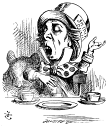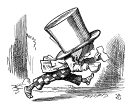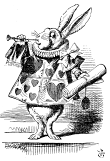Search us!
Search The Word Detective and our family of websites:
This is the easiest way to find a column on a particular word or phrase.
To search for a specific phrase, put it between quotation marks. (note: JavaScript must be turned on in your browser to view results.)
Ask a Question! Puzzled by Posh?
Confounded by Cattycorner?
Baffled by Balderdash?
Flummoxed by Flabbergast?
Perplexed by Pandemonium?
Nonplussed by... Nonplussed?
Annoyed by Alliteration?

Don't be shy!
Send in your question!
Columns from 1995 to 2006 are slowly being added to the above archives. For the moment, they can best be found by using the Search box at the top of this column.
 If you would like to be notified when each monthly update is posted here, sign up for our free email notification list.
If you would like to be notified when each monthly update is posted here, sign up for our free email notification list.
Trivia
All contents herein (except the illustrations, which are in the public domain) are Copyright © 1995-2020 Evan Morris & Kathy Wollard. Reproduction without written permission is prohibited, with the exception that teachers in public schools may duplicate and distribute the material here for classroom use.
Any typos found are yours to keep.
And remember, kids,
Semper Ubi Sub Ubi
|
A flummox of questions?
Dear Word Detective: I’ve just heard a new one that I can’t find in most of the usual authorities, while it appears plainly in others: a group of crows described as a “murder of crows.” Any clues? — KT, Albuquerque, NM.
Thanks for a great question. I’m surprised that you haven’t run into “murder of crows” before — the internet is full of compilations of such collective nouns, colorful terms for groups of animals, people or things. Some of the terms collected on websites, such as “an absence of waiters” or “an attitude of teenagers,” are clearly of recent vintage, coined in tiny fits of wit by the kind of people who drive their friends and families mad with constant puns. For me, a little of this goes a long way, and eventually “a brace of orthodontists” or “a disputation of lawyers” makes me feel like I’m trapped in one of those creepy-cutesy public radio quiz shows.
But it would be mistake to tar all of these terms as simply casual inventions in pursuit of a chuckle. Of course, someone did make them up. The entire English language was “invented” in one way or another. But the truly interesting collective nouns, such as “murder of crows” or “a cete of badgers,” were coined a very long time ago, mostly in the 15th century, and far from being merely fanciful inventions, these terms were once considered the proper way to describe a group of animals. Some, such as “a pride of lions” and “a gaggle of geese,” remain in common use today after being rescued from obscurity and revived in the 19th century.
We owe our knowledge of these terms today to several lists compiled in the 15th century, the most complete being “The Book of St. Albans,” attributed to Dame Juliana Barnes, prior of a nunnery in England. But for modern readers, the best introduction to the genre is “An Exaltation of Larks” (1968) by James Lipton (best known today as host of “Inside the Actors Studio” on the Bravo cable channel). Lipton divides his book into three parts: terms found in the 15th century collections that remain in use today (such as “a host of angels” and “a string of ponies”); old terms (such as “a cast of hawks” and “a knot of toads”) that were once common but have fallen into obscurity, and, lastly, oddities from the old collections. These mostly describe people, rather than animals, from the logical “an illusion of painters” to the intriguing “a rage of maidens” (employing “rage” in the 14th century sense of “jesting, fun; riotous or wanton behavior”).
As for why we call a group of crows a “murder,” the inspiration for the term is a mystery, lost since the 15th century. As the Oxford English Dictionary suggests, “murder” may “perhaps [allude] to the crow’s traditional association with violent death, or … to its harsh and raucous cry.” Then again, since crows have recently been demonstrated to be capable of advanced reasoning and even tool-making, maybe they actually did plot a few murders back in the 15th century.
Your future in a fist.
Dear Word Detective: Recently, on the way to a boxing class, my co-worker jokingly told me to “put up your dukes.” We both immediately wondered where that expression comes from, and I thought, of course, of you. Any insight? — Loren.
Boxing class, eh? Is that a college course? Things must have changed quite a bit. When I was in school, we took Tear Gas Studies and Advanced Annoyance of Authority Figures.
My attitude towards boxing, I should note, was formed at an early age when I discovered that you needed another person to help you lace up the gloves. I can’t quite explain why, but that really seemed to break the aura of ferocity one usually associates with the sport. It’s like asking your mom to start your motorcycle for you.
“Put up your dukes” is, of course, the classic challenge to engage in a fist fight, whether bare-knuckle or boxing with padded gloves. While there is no doubt that “put up your dukes” were serious “fighting words” when the phrase first became popular in the late 19th century, today proclaiming “put up your dukes” is regarded as either a joke or the mark of a comical buffoon (e.g., the Cowardly Lion in The Wizard of Oz or countless Bugs Bunny cartoons). We still speak, however, of candidates “duking it out” in election years.
The use of “dukes” as slang for “fists” seems to have arisen a bit earlier than “put up your dukes,” around 1859, and there are several theories as to the origin of this usage. The most elaborate traces “dukes” to rhyming slang, in which the intended word is replaced by a phrase in which one word rhymes with it; one standard example is “china plate” meaning “mate.” The phrase is then often shortened to the one non-rhyming word to further obscure the meaning (in this example, simply “china” as slang for “mate”).
According to this theory, “duke” is the remnant of the rhyming slang phrase “Duke of York” meaning “fork,” itself supposedly 19th century slang for “hand” because the fingers resemble the tines of a fork. This may seem an impossibly convoluted genesis for a simple bit of slang, but it is not unprecedented in the world of rhyming slang. A more serious objection to this theory is that while rhyming slang is popular in the UK and Australia, it has never gained much of a foothold here in the US, and the slang “dukes” definitely appears to be an American invention. Of course, we may have picked it up from immigrants, but there aren’t many popular American slang terms that can be traced to rhyming slang.
A much simpler theory about “dukes,” and one I find more likely, is that it comes from the Romany, or Gypsy, word “dookin,” meaning “fortune telling.” Since a staple of fortune telling is palmistry, it seems reasonable that “dook” was assumed, perhaps by non-Gypsy carnival workers, to mean simply “hand” and spread as slang from there, eventually changing its spelling to the more familiar “duke.”
Vox Sox.
Dear Word Detective: While looking up something only peripherally related to my question, I was struck by the term “bobby socks” or “bobbysoxer.” As a whole phrase it was defined on Wikipedia, which mostly explained the “socks” part. What it didn’t cover was “bobby.” Was this a term in reference to rolling the socks down? Or was it in reference to a “hair bob” or the bounciness (“bobbing”) of the “soxer”? I’m curious to know. — Jerry.
Me too. I was only vaguely aware of popular culture in the 1950s, being quite small during that period, though I do remember “bobbysoxer” being a buzzword among adults. But I was consumed at the time by my mission to build a tiny town out of twigs for the local birds, on which I spent the better part of one summer. The birds, however, resolutely refused to move into their little cabins, which is probably just as well, given the shoddy workmanship and rampant code violations.
Meanwhile, “bobbysoxers” roamed America and ruled the popular media. The Oxford English Dictionary defines “bobbysoxer” as “an adolescent girl, especially one in her early teens, wearing bobby socks,” while the Historical Dictionary of American Slang (HDAS) fills in the details: “A teenage girl usually regarded as naively immature and an enthusiastic follower of youthful fads in music, fashion, etc.” The HDAS pegs the first print appearance of the term “bobbysoxer” as being in 1944, and the species flourished at least until the early 1960s. If you’ve ever seen archival film footage of hyperventilating teenage girls with ponytails mobbing a young Frank Sinatra or (a bit later) Bobby Darin, those are “bobbysoxers.” The spelling “sox” is, of course, simply a popular re-spelling of “socks.”
The “bobby sock” from which “bobbysoxer” derives is an ankle-length sock, usually white, and usually worn with saddle shoes or oxfords. The “bobby” in “bobby sock” comes from the verb “to bob,” meaning “to cut short” (the socks were shorter than mainstream fashion at that time), which is the same “bobbing” that produces “bobtail” horses and “bob” (i.e., short) hairstyles (which also gave us “bobby pins,” originally designed to hold such styles in place).
The verb “to bob” comes from the noun “bob,” which first appeared in English in the 14th century meaning “a bunch or cluster,” possibly borrowed from the Irish “baban,” meaning “bunch or cluster,” as of leaves or grapes. In English, “bob” developed a number of meanings with the general sense of “round mass” or “hanging weight,” including the weight at the end of a fishing line or pendulum. It is probably from this sense that “bob” meaning “move up and down” came, so when “bobbysoxers” jumped up and down in excitement, they were displaying two separate, but related, senses of the same word.
|
Makes a great gift! Click cover for more.  
400+ pages of science questions answered and explained for kids -- and adults!
FROM ALTOIDS TO ZIMA, by Evan Morris
 
|


 can be found
can be found 




Recent Comments